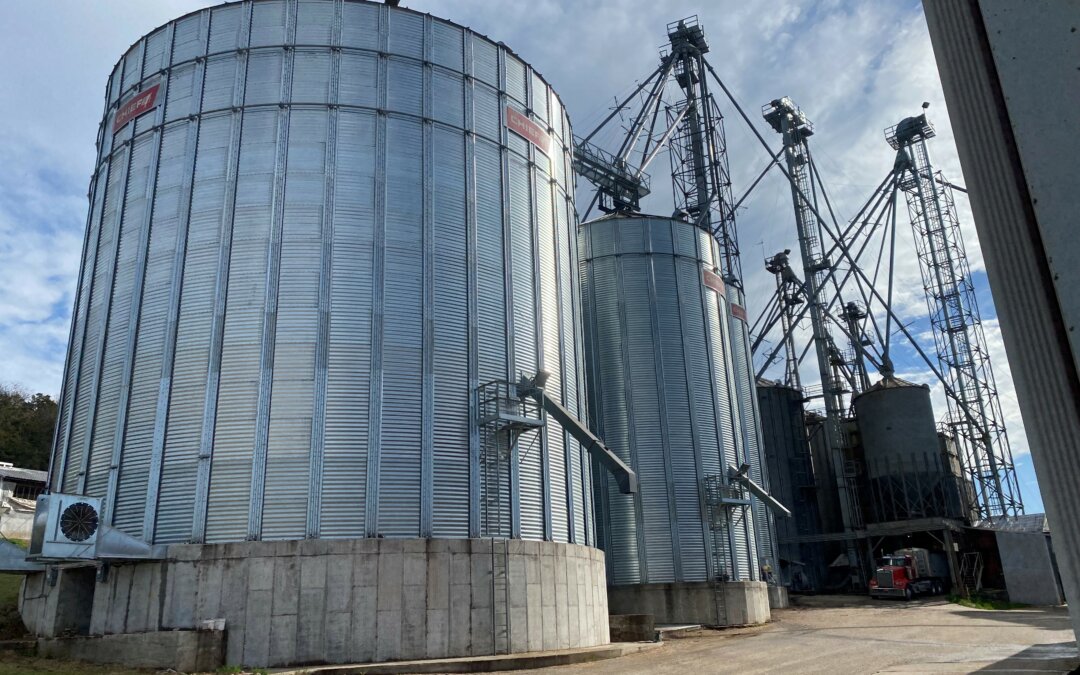When farmers need to expand their grain storage capacity, choosing the right storage solution requires intensive planning.
First, you must determine what bushel capacity you need and what your farm can accommodate.
Next, think about your current storage limits, what your future needs might be, your available footprint and budget, and if you’re limited by height restrictions or power capacity.
Once this legwork is complete, you can determine precisely which grain storage options match your needs. Here are a few things to consider when developing a grain storage strategy.
Reasons to incorporate permanent grain storage structures
Most agricultural producers looking to add grain storage systems to their properties are considering permanent structures. Grain piles and temporary storage risk yield loss, while permanent structures protect crops and increase loading speeds.
Also, grain prices are typically higher during the marketing season than during the harvest, so successfully storing grain means more money for your hard-earned yield. Chief Agri’s domestic sales manager, Shad Singleton, frequently sees another compelling reason to shift to a permanent storage structure. “Often, it’s labor,” he says. “Farmers need to develop a facility that requires the least labor to operate.”
A Chief Agri solution for every operation
Chief Agri has served the agricultural community since 1961 and produces a full line of storage systems for grain and commodity crops that meet the needs of small farmers and commercial growers alike. From farm bins to hopper tanks and commercial storage bins, Singleton and Jose Meza, Chief Agri’s district sales manager for Iowa, know Chief Agri’s grain storage solutions inside and out.
Farm bins
Chief Agri produces a line of farm bins that are ideal for use on a small farm. Ranging in diameter from 15 feet, 6 inches to 49 feet, 6 inches, with heights ranging from 19 feet, 2 inches to 82 feet, 3 inches, there’s an option suited for your operation. “For many of our family-run farms, they’re limited on how many people they have during the harvest,” says Meza. “On-site storage gives you better access to quality storage, so farm bins save time for a small or mid-size farmer.”
Cutting corners to save money at the expense of storage capacity can cause issues in the long run. “Grain that’s safe in the bins is money in the bank,” Meza says. By storing the grains safely and effectively, you can ensure that you don’t run into issues with your yield down the line.
Commercial bins
Large commercial bins provide flexibility to accommodate the unknowns of fluctuating harvests and markets. Chief grain bins offer various roof options, including heavy-duty industrial roofs, to handle the farmer’s peak loading capacity, expected snow loads and other environmental conditions. “Most of these large systems are designed to be added onto easily,” says Singleton. “And you can respond to factors and trends that drive commodities.”
Hopper tanks
Chief hopper tanks are multi-use and engineered to provide long-term reliability. They give farmers a convenient way to load trucks, as grain can easily flow out of the bottom when opened into an auger. Depending on the grain’s moisture content and current conditions, you can add air to hopper tanks too. “Just one-tenth of a cubic foot per minute should be fine,” Meza says. However, they do have certain drawbacks. “You’re limited for bushel capacity,” says Meza. “They’re not as big, storage-wise, but farmers can do multiple tanks and use the same auger.”
Modular bin systems
Next in Chief’s diverse line of storage systems are their modular bins, used across multiple industries. Designed to store dry bulk materials, feed ingredients, aggregates and grains, these modular bins keep products dry and clean with easy gravity retrieval.
“We’re doing a huge kitty litter facility right now,” says Singleton. “Coffee, sawdust — it can be used in many sectors outside the grain industry.” With its modular design, there’s no limit to how many units you can combine into the ideal system for your operations.
Temporary storage
Nowadays, even temporary grain storage systems are more sophisticated than they used to be. Chief offers three temporary storage solutions, including retaining walls and grain pile systems. While temporary storage can provide flexibility and lower storage system costs, Singleton cautions against relying too heavily on them. “It’s extremely labor intensive to clean up,” he says, noting that the process requires numerous folks to run loaders and trucks simultaneously.
A personalized touch to grain storage solutions
Grain storage systems are complex and take careful planning. When you invest in a solution with Chief, you’ll get a partner you can turn to throughout the entire process.
Chief Agri has an extensive network of dealers throughout North America. Your local Chief Agri dealer will help you build a detailed master plan to cover your long-term grain storage needs.
“From start to finish, we’re involved and provide personal attention,” says Singleton.
For more information, visit agri.chief.com.
Sponsored content by Amy Carpenter-Driscoll, Brand Ave. Studios contributing writer.

